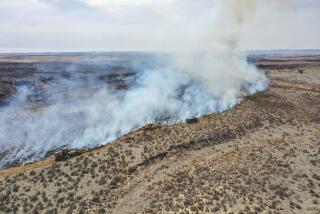Texas explosion: Ammonia or ammonium nitrate suspected
- Share via
The explosion at a Central Texas fertilizer plant Wednesday night could have been caused by ammonia gas or the more well-known explosive, ammonium nitrate, according to chemists.
Neal Langerman, principal chemist with Advanced Chemical Safety, a San Diego industrial consulting firm, said the initial fire could easily have caused anhydrous ammonia to explode catastrophically.
“It’s really hard to ignite, but it’s a flammable gas,” Langerman said. “If a tank containing a liquefied flammable gas is subjected to fire, that tank could fail catastrophically, releasing the gas, which will instantly ignite, causing a catastrophic explosion, as was seen.”
A robust fire also would be needed to ignite ammonium nitrate, a well-known explosive used in industry and adopted by terrorists. A ship loaded with ammonium nitrate at a dock in Texas City exploded after a fire in 1947. The blast killed more than 500 people and leveled much of the port town.
“In general, ammonium nitrate is not unstable – only at high temperatures or with a pretty powerful explosive blasting cap,” said Ron Smaldone, an organic chemist at the University of Texas, Dallas.
“If you have a large amount, that heat will build up,” he said. “This doesn’t appear to be the case.”
But the chemical can explode at about 200-250 degrees Fahrenheit, Smaldone said. “Once the reaction starts, it’s really pretty much unstopable. It’s like dynamite. You can’t put it out with a fire extinguisher.”
Smaldone said that putting water on the initial blaze at the plant should not have had any explosive effect on the chemicals stored there. “I really doubt the water had anything to do with the explosion, at least from a chemical perspective.”
Facilities that store ammonia gas in quantities similar to that of the West, Texas, plant are common in California’s Central Valley, said Langerman, who has studied the local industry.
“I was genuinely impressed with the compliance of companies handling anhydrous ammonia,” he said.
Farmers generally will buy a 550-gallon “nurse” tank of the gas, back it up to an irrigation source and “bubble” it into the water, making ammonium hydroxide, a fertilizer. “It’s exceedingly soluble in water,” Langerman said.
That’s potential good news for the town where the explosion occurred, particularly because it rained overnight. “Most of it was burned off and what wsn’t burned off was washed out in the rain.”







